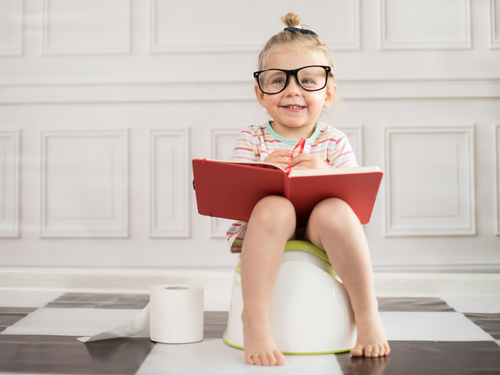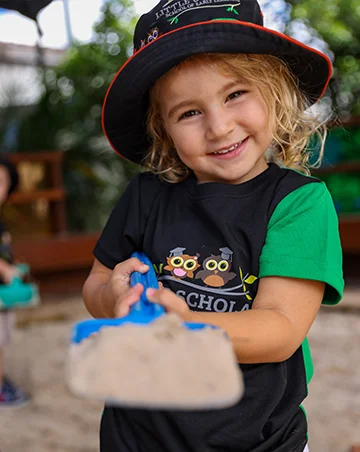Don’t do it alone. We are here to help.
Including us (the Little Scholars crew) in the toilet training process is invaluable because our Educators often are among the first to recognise when a child is developmentally ready to toilet train, we can communicate with you and provide appropriate and continuous toilet training methods and messages, and we can help teach your child proper toilet training practices.
Little Scholars believe It’s important that we work in partnerships with parents while the child is learning to use the toilet.
For a child, toilet training is a big milestone. It’s also a time for them to learn to attune to their bodily functions and to understand when it’s “time” to go to the toilet. During this time you need to be patient and encouraging – the child is learning a new skill and it’s often and a process of trial and error and accidents will take place
Parents, as well as the educators, need to be on the same page when it comes to supporting a child through toileting. We like to talk to parents to know what is happening at home in regards to toileting. A general rule is that toilet training should be started at home before toileting starts at the campus.
Toilet training trouble getting you down? Take comfort in knowing that you are not the first parent to experience this – and you won’t be the last! Learning new skills can be a challenge for toddlers but none are quite so fraught with worry – and the potential for mess! – than learning to use the toilet independently.
Don’t give up hope just yet! Read our five tips for an easier transition into successful toilet training.
1. Look for signs of toilet training readiness
One of the biggest mistakes parents can make is to begin toilet training before their child is truly ready. Pushing a child to learn a task they are not mentally and physically ready for is a recipe for tears – both yours and your little one’s. Most children become ready to toilet train between the ages of 2 -3 years old. Some require very little encouragement and others may need a gentle nudge in the right direction.
Look for the following signs to gauge readiness in your toddler.
- Growing independence. Is your child keen to make their own choices and do things for themselves? This desire to take some control of everyday tasks – especially the ability to pull their own pants up and down with minimal assistance – is a good indicator that your child is nearing readiness.
- Nappies stay dry for up to two hours. If your child can hold wee in their bladder for extended periods, this shows increasing bladder control which is crucial for toilet training success. In infants, the bladder will empty automatically so it’s important to ensure your child is no longer in this stage.
- Can communicate the need to wee or poo. Whether verbally or with gestures, toilet training readiness relies on your child’s ability to let you know they need to go. Without this, accidents are much more likely.
- Dislikes the feeling of a dirty nappy. If your child is keen to remove a wet or soiled nappy, this can be a good point to introduce the benefits of using the toilet and wearing lovely, dry undies. No more yucky, uncomfortable nappies!
2. Choose an appropriate time to start
You’ve seen some of the signs of readiness in your child so you want to begin toilet training right away. But wait? Is now the right time? Here are some things to consider.
- Don’t begin toilet training during times of family stress or upheaval. If you’ve just moved house or brought home a newborn sibling, chances are your toddler is already quite busy dealing with those changes. Wait until things are more settled.
- Are you ready? Remember that toilet training can be slow going so it’s best to prepare for the long haul. If you’re feeling particularly overwhelmed or stressed with life, chances are this will impact negatively on the toilet training journey. Take a deep breath and remember that patience and persistence will win in the end.
- Potty or toilet? You need to decide which one you’ll choose. A potty can be less frightening than the toilet – and it’s portable. Gauging what your child is most comfortable with is a good way to choose. Make sure you have all the equipment ready to go before you start.
3. Beginning toilet training
You’re ready, your child is ready! Now what?
- Begin by sitting your child on the toilet or potty at regular intervals. Wait 3 -5 minutes. If nothing happens, praise your child for sitting but allow them to hop off otherwise it may begin to feel like a punishment.
- Give the child gentle reminders throughout the day by asking if they need to use the toilet. This helps them to start thinking about the sensations that occur in their body that lets them know it’s time to go.
- It’s best to have your child wearing underpants during training. It’s tempting to use a pull-up or nappy in between visits to the loo but the familiar feeling of the nappy makes it easy for your child to forget that they’re meant to use the toilet instead.
- Allow for accidents. They almost certainly will happen. The appropriate response is no response. Just clean up the mess and reassure your little one that they can try again. Never shame or scold your child as this has the potential to turn the toilet training process into a negative which can set your child back significantly.
- Praise, praise, praise. If they use the potty or toilet, shower your little one in praise! These milestones are tricky. Be sure to remind them how proud you are of their progress.
4. Toilet training when out and about
Toilet training at home is one thing but heading out with a newly trained toddler in nickers is quite another! If at all possible, it’s best to avoid long trips away from home until the training is well-established and your child can stay dry for extended periods of time. If this isn’t practical, the best plan is simply to be prepared.
- Have your child use the toilet before you leave home.
- If you’re using a potty, take this in the car.
- Always bring a spare set of clothes.
- Make sure there are opportunities for your child to use the toilet while out. Regularly and gently remind them.
- Praise, praise, praise! Yep, if they manage to stay dry or they use a public toilet successfully, let them know what an awesome job they’re doing!
5. Be patient
For some children, toilet training is a cinch. Others take a little more time. Whatever you do, don’t bother with comparisons. Every child is beautifully unique and their journey is their own. If you meet with very strong resistance and absolutely no success initially, leave it for a little while. The greatest setback to toilet training success is when it becomes a huge and unpleasant battle. Take a breather and revisit again – in a week, in a month. If you tried repeatedly with no luck and your child is heading towards four years of age, it can be useful to see your family doctor for further advice and to rule out any other issues.
But remember, with loving support and encouragement, your child will eventually get there. You can do this!
Find out more about the premium facilities and unique learning opportunities at Little Scholars. Arrange your tour today.



